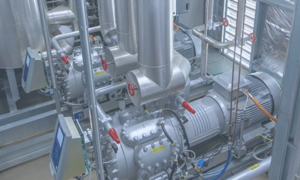A panel of industry’s leading experts has ideated their views on the ongoing initiatives pertaining to the existing energy conservation, insulations and other innovations practiced in India.
Heating Ventilation and Air-conditioning (HVAC) system consumes almost 50 percent of the total energy, which makes it a vital aspect. Residential and commercial buildings account for almost 30 percent of the total energy consumption in India, and the share is expected to boom even more by 2042. Technologies and measures that aim at enhancing energy efficiency as it reduces the cost implications, reduces the environmental impacts and sustains efficiency in a system. Being in a cost conscious country like India, we insist for affordable cooling solutions; so meeting the demands for affordable energy efficient systems happens to be a paramount factor. Limited access to affordable efficient solutions leads to adaptability of low-efficient air-conditioners and high-GWP refrigerant cooling systems, further leading increased carbon footprints. India Cooling Action Plan has set targets across various sectors to ensure affordable and sustainable cooling, including for the servicing sector.
Existing energy conservation practices
India has been efficient in many of its forms. People actually underestimate India in a way if you see in India the cement sector specifically is number one in energy consumption energy consumption in the entire world. And to be more specific, we do have a right system in place. Balasubramanian MB – Counselor – CII-Sohrabji Godrej Green Business Centre, says “Looking at the India Cooling Action Plan, how much additional cooling has to be out of the refrigeration system has to be brought in from the reefer systems for the farmers to the end product, or in order to increase efficiency in the HVAC system, we are expecting a lot more to be improved in India. Talking about the future, I believe in more and more ESCO or energy saving companies that implement the prod product and based on the energy saving, you get more and more returns and you can pay them in installments on that basis as well. So, that can be a consideration of future.”
Energy conservation from thermal insulation
Conservation can be done through thermal insulation. With the India Cooling Action Plan, come into action, are a lot of HVAC applications in terms of comfort and process are expected to come on the market. Elaborating on the insulation practices, Hiten Harish Patel – HVAC professional & Thermal & Acoustic Insulation Expert, IGBC AP, Shree Jashraj Enterprises says that while talking about thermal insulation, we need to consider the key value of it, the norms and the installation cost, as every consultant has their own experience in this field. So when those norms will be at place, there will be a lot of energy savings. “Since India is a growing market, cooling has become more of a luxury than an asset. So these energy efficient systems if integrated with insulation with the capital equipment, there can be a huge reduction on the carbon footprints.”
India’s net-zero status
Net-zero energy is something that we are looking ahead particularly in the building sector achieving for the building sector. It has been a major concern and we are looking for future prospects of having Net-zero systems and buildings. We also have ample of solar technologies like wind and hybrid systems that can be brought in. We at CII we can help you also achieve it there is a separate ICBC rating system specifically on net zero energy building. So, we have been helping people in achieving net zero energy building and we will continue providing required support in the future. Moreover, this definitely can encourage achieving the net zero energy probably the next step that we must look upon along with zero carbon footprints. But, but zero energy is something which we can easily achieve, it is possible to achieve specifically with the amount of space and other things will be added and it is not necessary that we have to look at only the installation of the on-site systems that are issued we can also look at the installations on the off-site systems also to achieve that zero energy that we are looking at what comes in the way for us to create such norms and ahead for India.
According to Aneesh Kadyan, Executive Director – Property Management, CBRE South Asia Pvt. Ltd., India has already started adapting the concept of Net Zero in their buildings. A lot of new buildings are coming up which are following the efficiency norms and standards, and I am sure that Mr. Jhala and Mr. Hiten must be working with them in terms of insulation and HVAC designs, and Mr. Balasubramanian must be providing them the right consultation. In fact, we already have a Net Zero Building in Delhi – Indita Paryavaran Bhavan, which had attained ASHRAE’s Building Excellence Award. So the government is actually taking all efforts in introducing such buildings even in the private sector like –Mumbai airport. So, we do have efficient buildings but India needs more focus on the air-conditioning side as well. I think it is just a matter of time, because costs are increasing every day. So that will force people to shift over to more energy efficient manner.
Critical aspects of existing energy efficiency norms
We do have norms which consider all the generics with standard thickness. “If you talk about the applications for a commercial building, IT building from the insulation perspective, I see plant room, shaft areas every single location requires different installation and different application”, says Hiten. As an insulation expert I think the pattern changes for every location. We also have National Building Norms (NBC) 2016 norms, they have a standard thickness which has been mentioned and there are various generics which have been mentioned, so people they pick as per their experience. “I think this might come with more stringent norms. Talking about under deck insulation, it’s rarely done for residential areas and industrial areas, where in, it is the most critical aspect while having a solar rooftop installed in your premises. While the solar absorbs the heat and contains it, one must realise that this will further increase the heat load. This is where the under deck insulation will play a key role in comforting the system.”
Adding to this Aneesh mentioned about the ASHRAE 90.1 standards for installation requirements and gradients for the heat loss. So, I think here, consumer awareness is one of the major barriers. We need to more push from the consumers by demanding required insulations, which we don’t see so far. Secondly, people must consider insulation as a critical aspect for a system which is missing right now. We must educate them on the importance of having an quality and effective for better efficiency and better functioning of their systems.
Balasubramanian on the other hand says, “The IGBC and other rating systems also consider the insulation and all the ASHRAE norms have been followed on a continuous basis. And actually you get more points in doing better on an overall rating by encouraging it to attain one of the best buildings in terms of energy efficiency also.”
Having geothermal systems for energy efficiency
A geothermal system is rarely used in India. We have very few installations at the moment. CIS Mohali has been running on geothermal systems right from its inception of more than 10 years. The success rate we see is very high. With geothermal systems, we can get variable temperature at different places. Today, they are ready to consider the geothermal system in a much better way.
According to Aneesh, a systems success depends on various factors. Most important factor is to have the willingness to make it a success. So geothermal system unfortunately, while they bring a lot of potential, but because of the higher initial costs and the maintenance aspects these systems are rarely installed.
Attaining energy efficiency in public spaces
If you don’t want to speak about public spaces when generally comes across the federal buildings or government buildings more specifically, while of course you have malls are also public spaces. But I’ll come to the federal aspects; we have standards prescribed by GRIA Council and IGBC. But the adoption of these standards was very poor earlier in the federal buildings. But the Government of India, in the last 6 years had mandated that one must approach the GRIHA Council and follow their standards.
“I think is accountability and maintainability for management of commercial buildings and public places which are being done by the organisations like CBWD, and all who do the maintenance. But there are constrained in terms of the way that they approach the maintenance, it’s generally standalone”, says Aneesh. For instance, there is a commercial building that CBRE manages, we manage the entire budget. This also enables us on the required technologies which will enhance the efficiency of the chillers, and will give a payback period of two years, this brings us at ease while the implementations. Whereas in federal and public spaces, the implementation consume more time, because it is a public money which has been spent, so here comes the accountability on the public money spent.
And then we have usage patterns. In a commercial private building, you have a lot of control on who comes in who goes out. You have control over how much you spend on the systems, where the building owner is responsible. In public buildings, ownership, of course is not always very clearly defined. But when comes to expenditure done by the building owners towards the buildings efficiency, I see the efficiency quality gets compromised. This restricts us from focusing towards energy efficiency. But in the recent six years, this trend has been changing. Today, we have tremendous new buildings coming up out of which some re following the efficiency index.
Here, V D Jhala, Managing Director, Ask Group of Companies, shares an experience regarding building insulation, “I would like to give an example of Australia, where one of my close relative is going to buy a new bungalow in Melbourne and I saw the brochure, and the government has imprinted the entire design including those for the insulation purposes. The day when India starts enacting upon such activities, we will proudly call it a green building.
OEM’s role in sustainable buildings
“Yes, definitely, OEMs are the one to take this ahead and they cannot be kept away from this energy efficiency dialogue. BEE has mandated the implementation of it. They have actually revolutionised the way manufacturers are focusing on energy, energy efficient systems and equipment” explains Aneesh. So OEM has a vital role to play, and incentivising the OEMs as they are spending a lot on their R&D and coming up with innovations in highly efficient chiller or a low efficient, low energy use pumps. The amount can be spent like this only when we have enough market for it. And the market for efficient products can flourish only when the government thrusts upon energy.
Balasubramanian on the other side highlights that the IGBC and the CII have been continually in dialogue with the OEMs to look at possibilities to consider the ESCO model for the companies. Also, there are a lot of companies that implement the energy efficiency standards and technologies in their product. Also, OEMs look at the guarantee performance-based systems to ensure energy efficiency. So, these are the two major things we have been in continuous engagement with the suppliers. Lastly comes the end user; we have met with issues where the end user is unable to manage the technology, as he lack the knowledge and awareness about the product or the technology. So, again, awareness is the key part here. Not just the OEMs but the customers and the consumers must be able to realise the in and out of the technology.
Impacts of import restriction in air-conditioning systems
Regarding the air conditioning system nowadays, I talk about the installation only not of the mechanical part all manufacturers should go for as per the international standard of this insulation system. So, as the efficiency of the insulation system get increased, nowadays IS standards has become a generic term, but it is not just the ISO standards we have. We must also look at the Eastern Standards which are supposed to. According to the Eastern Standards, one should install and attain quality products right at the time of manufacturing. This has been mandated in order to attain increased efficiency in an air conditioning system. But here, we don’t have much of such emphasis or a mandate.
Talking about the impacts of importing insulation, Hiten says “Lighter material and transportation cost plays a very important role. So the cost for imports exceeds and so does the factory reach. We prefer to have more manufacturers in India, particularly near the factory site. This will reduce the cost complications. And as Mr. Jhala mentioned earlier we follow ISO standards. When we talk about energy saving, I think we must take lessons from the ASTM and EURO Standards. There are various categories available with us now, if you have a fire standard which you follow the Euro standards then there is a different material in the same generic which has to be used, but of course, the cost is higher if you have a you know a green building project which is coming up you can come up with those kinds of products which has those euro standards which can save on energy which can give you more fire norms you know all those coin if you club together if integrate together then we can have you know solution to the cost as well as the you know application part.
—————————————————————————————————————————————-
“Integrating energy efficient equipment and insulation with the capital equipment, there can be a huge reduction on the carbon footprints.”
Hiten Harish Patel – HVAC professional & Thermal & Acoustic Insulation Expert, IGBC AP, Shree Jashraj Enterprises
—————————————————————————————————————————————-
“With required push from the government industry, I see net-zero buildings and net-zero India in the coming years.”
Balasubramanian MB – Counselor – CII-Sohrabji Godrej Green Business Centre
—————————————————————————————————————————————-
“To become a rated and official green building of international standards, we need to start imprinting thermal insulation building designs in the brochur.”
V D Jhala, Managing Director, Ask Group of Companies
—————————————————————————————————————————————-
“To attain energy efficiency in public spaces, one must own the accountability and maintainability of buildings entire system.”
Aneesh Kadyan, Executive Director – Property Management, CBRE South Asia Pvt. Ltd
—————————————————————————————————————————————-
Cookie Consent
We use cookies to personalize your experience. By continuing to visit this website you agree to our Terms & Conditions, Privacy Policy and Cookie Policy.















